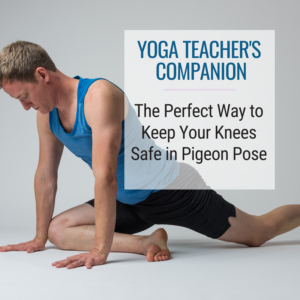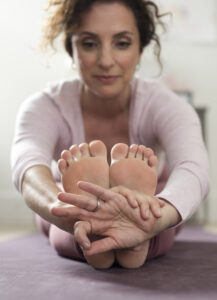
The thoughtful and articulate Bernie Clark joins us on the show this week! Bernie is perhaps best known for his influential Yin yoga teachings as well as his books, The Complete Guide to Yin Yoga, and Your Body, Your Yoga.
When Jason and I shared our thoughts about Yin Yoga at the end of season 1 (episode 147), we hadn’t expected it to be so polarizing. After seeing Bernie’s response to the episode in one of his forums and after listening to you, our listeners, we asked him on the show.
We covered a lot of ground in this episode: Bernie clarified Yin’s origin story, he shared how Yin benefits him personally (and how he complements it with strength-training), as well as how he guides (even flexible students like Andrea) to discern their edge in poses. The big takeaway from the conversation? We landed on more points of agreement than points of difference. The one point of difference that remains is whether or not lengthening ligaments is a good idea. And if you’d like to research that further, check out the show notes.
RECOMMENDED AND RELATED LINKS
The following links are intended to help you take personal responsibility for your body and your practice. Our hope is that they can help you determine what resonates with you and feels right in your body.
Blog posts and citations from Bernie
In Defense of Yin Yoga
A Scientific Basis for Yin Yoga
Helen Langevin: The Science of Stretch
The Complete Guide to Yin Yoga by Bernie Clark
Citations from Jason:
“When a tendon/ligament is stretched beyond physiological limits, some fibrils be‐ gin to fail. Micro failure accumulates, stiffness is reduced and the ligament/tendon begins to fail. This occurs when intramolecular cross-links between collagen fibers fail. The tendon therefore undergoes irreversible plastic deformation. When the tendon/ligament is stretched to more than 8-10% of its original length, macroscopic failure follows.”
Injury and Repair of Ligaments and Tendons
“Dynamic or static muscle action creates internal resistance in the loaded structures (stress) that counteracts deformation (strain) of the tissue. All tissue has a characteristic ability to tolerate deformation and stress, and injuries occur when the tolerance level is exceeded. An acute injury occurs when loading is sufficient to cause irreversible deformation of the tissue, whereas an overuse injury occurs as a result of repeated overloading either in the loading itself or through inadequate recovery time between loadings. Each incidence, alone, is not enough to cause irreversible deformation, but the repeated actions can result in an injury over time.” Olympic Committee Manual of Sports Injuries: An a Guide to the Management of Injuries in Physical Activities
The Science and Physiology of Flexibility and Stretching: Implications and Applications in Sport Performance and Health, Professor David G. Behm, November 2018
Episode 147: Jason’s Take on Yin Yoga
WRITE A YOGA PODCAST REVIEW
If you like the podcast, please leave a review or rating on iTunes! It makes it easier for others to find the podcast. If you don’t know how to leave a review, here are some step by step instructions. Woohoo! So easy!
SHOUT-OUT TO OUR SPONSORS
Ohmme is a company that makes yoga and activewear clothing for men. The fit and function is phenomenal. Plus, their design and manufacturing process is sustainable since they use many recycled materials. For 20% off your Ohmme order, visit ohmme.com and use promo code YOGALAND20.








